Solenoid Actuator, Linear Actuators, Push Pull Actuator Solenoid Driven Actuator
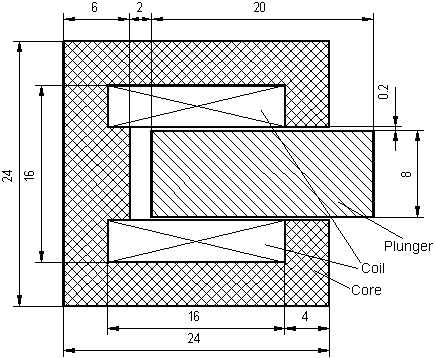 A solenoid actuator is an example of electromechanical transducer, which transforms an input electric signal into a motion. Solenoid actuator, considered here, consists of a coil enclosed into a ferromagnetic core with a moving part - plunger inside. Actuator design requires calculation of the magnetic field and a force, applied to the plunger.
A solenoid actuator is an example of electromechanical transducer, which transforms an input electric signal into a motion. Solenoid actuator, considered here, consists of a coil enclosed into a ferromagnetic core with a moving part - plunger inside. Actuator design requires calculation of the magnetic field and a force, applied to the plunger.
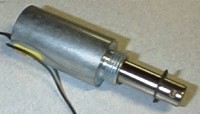
The Solenoid
Solonoids are actuators capable of linear motion. They can be electromechanical (AC/DC), hydraulic, or pneumatic driven - all operating on the same basic principles. Give it energy and it will produce a linear force. They are great for pushing buttons, hitting keys on a piano, valve operators, and even for jumping robots. DC solonoids operate on the same basic principles as a DC motor, so you should read that tutorial before continuing. The difference between a solenoid and a motor is that a solenoid is spring loaded and cannot rotate.
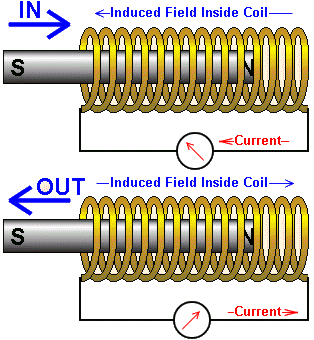
How Solenoids Work
Inside a solenoid is motor wire coiled in a special way (see image above). When you send an electric current through this wire (energized), a magnetic field is created. The inner shaft of a solenoid is a piston like cylinder made of iron or steel, called the plunger or slug (equivalent to an armature). The magnetic field then applies a force to this plunger, either attracting or repeling it. When the magnetic field is turned off, a spring then returns the plunger to its original state (see image below).
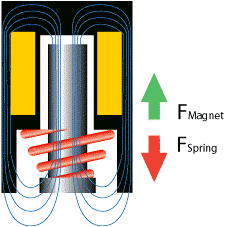
Push and Pull Type Solenoids
There are two main types of solenoids. The type directly refers to the solenoid start and energized positions, and is very important to understand. In pull type solenoids (image above), the plunger is normally outside the solenoid because the spring naturally forces the plunger out. Yet when energized, the force 'pulls' the plunger into the solenoid. Push type solenoids are the opposite, in that the spring forces the plunger into the solenoid, but when energized the plunger is 'pushed' out.
Powering a Solenoid
You should probably have figured out by now that solenoids are polarized, in that they only work when current is going the required direction. After all, you cant make a push solenoid pull . . . This is great in that you do not need a H-bridge or an expensive motor driver. A single MOSFET and/or relay will due.
You should also know that an electromechanical solenoid can melt if you power it too long. Always make sure that the power rating is not less than the voltage x current draw applied to your solenoid. The solenoid can of course exceed the power rating for short intermittent periods of time, but will overheat and melt with extended actuation periods. Consider heat sinking them if required.
Know that since solenoids have high inductance, when actuating one expect a short lived but very high power voltage spike to occur. This is just like driving a DC motor in one direction, then suddenly reversing the direction. Be aware of this when designing your control circuitry - making sure your circuit is high current, high voltage, and reverse current protected. After this short lived (~50ms) voltage spike, the voltage will balance at the hold voltage.
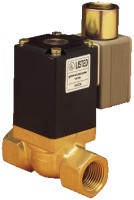
Mechanical Considerations
One very important thing to consider with a solenoid is the stroke. You need to make sure the stroke distance (maximum distance a plunger can travel) is sufficient for your application, but also to design your mechanics to handle the sudden non-linear high speeds and high forces expected from such an actuator. You may even need to consider dampening if this is a potential problem.
 |
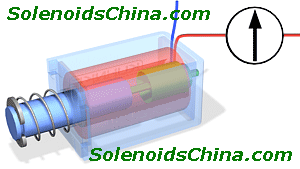 |
What is an Actuator?
Put simply, an actuator is something that converts energy into motion. It can also be used to apply a force. An actuator typically is a mechanical device that takes energy, usually created by air, electricity, or liquid, and converts that into some kind of motion. That motion can be anything from blocking to clamping to ejecting. Actuators are typically used in manufacturing or industrial applications and may be used in things like motors, pumps, switches, and valves.
Perhaps the most common type of actuator is powered by air — the pneumatic cylinder, also known as the air cylinder. Air cylinders are air-tight cylinders, typically made from metal, that use the energy of compressed air to move a piston. Air cylinders are most commonly used in manufacturing and assembly processes. Grippers, which are used in robotics, use actuators driven by compressed air to work much like human fingers
Actuators can also be powered by electricity or hydraulics. Much like there are air cylinders, there are also electric cylinders and hydraulic cylinders where the cylinder converts electricity or hydraulics into motion. Hydraulic cylinders are often used in certain types of vehicles.
Many actuators have more than one type of power source. Solenoid valves, for example, can be powered by air and electricity. Electricity powers the solenoid, and the solenoid, powered by air, actuates the valve. Alternatively, the solenoid can be powered by hydraulics and electricity.
Actuators can create a linear motion, rotary motion, or oscillatory motion. That is, they can create motion in one direction, in a circular motion, or in opposite directions at regular intervals. Hydraulic and air cylinders can be classified as single acting, meaning that the energy source causes movement in one direction and a spring is used for the other direction. Alternatively, these cylinders can be double acting cylinders, meaning the energy is used in two directions.
While actuators are typically discussed in terms of mechanical implements, muscles are sometimes given as an example of an actuator. Energy (e.g., created by eating carbohydrates) is converted by the muscle (i.e., the actuator) into motion (e.g., kicking a ball).
- Linear Solenoids
- Electromagnets /AX
- Bistable Rotary Solenoids /AP
Rotary Solenoids /AZ - Solenoid Valves /AF
- Solenoid Pumps /AT
- Solenoids by Applications
☞About SolenoidsChina.com
- ISO9001 (ISO9000)
- ISO14001 (ISO14000)
- Sales@SolenoidsChina.com
- Tel.: +86 137-9847-6858
☞
Contact SolenoidsChina.com
Sales@SolenoidsChina.com
www.SolenoidsChina.com
Tel.: +86 755 2802-0986
Cell.: + 86 137-9847-6858
PIC: Bai (Mr.), SolenoidsChina.com
Addr.:
:YaXin, 4/F, Building 3, YuePeng Ind. Zone, 107 GuanLanDaDao Rd., Shenzhen, China
Post Code: 518110